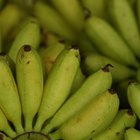
Clementine peels are most commonly used in oil production and to make candied peels, but there is no reason that you cannot eat them together with the inner flesh of the fruit. Clementines are characterized as having a thin and easy to remove peel compared to other citrus fruits and are widely available throughout the winter months. Eat them whole or peel them, but don't wait around to buy them too long, as they are only typically available from November through January in the United States.
Clementine Basics
Clementines are small mandarin oranges, a particular species that is part of the larger Citrus genus. While the name clementine is often used interchangeably with tangerine, these are in fact different cultivars of the same mandarin orange species. Native to southeast Asia and the Philippines, mandarin oranges have a history dating back to 2200 B.C. Primarily grown in California and Florida in the United States, clementines are widely sold throughout the country and packed with vitamin C, which is essential to maintaining a healthy immune system.
Behind the Peel
Clementines waste very little in their production. While most consumers tend to stick with just the inner fruit, both the seeds and peel are useful and are used widely in commercial production. The peel of clementines is processed to make oils, as well as marmalade, pectin and citric acid. The seeds of the clementine are also pressed for their oil. The peel can be eaten fresh or it can be candied into a sweet treat.
Putting Peels to Use
If you don't want to just bite into your clementine like an apple at home, there are other ways to enjoy the peel of a clementine. First, though, if you are planning to eat the peel, wash the clementine thoroughly to remove any trace pesticide on its surface or choose organic clementines. Slice a peel into thin strips and let it air dry for a few days before steeping it in hot water for a flavorful citrus tea. Clementine peels can be made into a fragrant zest used in flavoring baked goods and candies, or you can slow cook them in a sugar syrup until their natural water evaporates and they become candied. Add the peel to braising liquid when cooking meats to enhance flavor or simply throw the peels in vodka to infuse their fragrance into your favorite cocktails.
Clementine Uses
Clementines are most widely eaten as a snack food, as well as used to give a vibrant color and citrus flavor in many other dishes. Because the small mandarins are easy to peel, they are a perfect choice for snacking on the go. The segments can also be broken apart and clementines can be served atop a green salad or fruit salad for a tangy, yet sweet burst of color and flavor. Juiced, they are very sweet and can be enjoyed on their own or cooked into sauces for a bright, citrus flavor.
Related Articles

What Is Mixed Peel?

How to Eat the Peels of Tangerines
What Fruits Have Edible Peelings?

List of Tropical Fruits

How to Make Candied Orange Peel

Candied Fruit for Baking

Information About the Orange Fruit

How to Remove Seeds From Concord Grapes
How to Eat Asian Pears

Types of Greek Fruits & Vegetables

How Much Fiber Is in a Tangerine?

How to make Orange Extract

How to Remove Peach Fuzz

Ways to Use Candied Orange Peel

How to Juice a Daikon Radish

How to Cook Papaya

How to Eat a Quince

Peeling the Spiny Chayote Squash

Why Pears Turn Brown When Pureed

How to Preserve Nectarines
References
Writer Bio
Based in Portland, Ore., Maxine Wallace is a writer with more than 12 years of experience. With a bachelor's degree in journalism and experience working on marketing campaigns for large media agencies, she is well-versed in multiple industries including the Internet, cooking, gardening, health, fitness, travel and holistic living.
Photo Credits
Medioimages/Photodisc/Photodisc/Getty Images